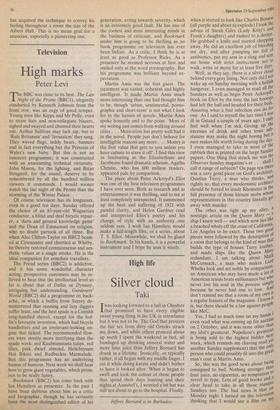Music
West meets East
Peter Phillips
According td the latest edition of Grove's Dictionary, the English rul- ing classes in India 'did nothing' for native music all the time they were there, not as the result of any deliberate policy of non-intervention, but simply because they 'were unable to accept Indian art music as anything more than barbarous, quaint, or at best the decadent legacy of a golden past.' I find this most depressing reading. It is often hard to quantify the uneasy im- pression I have grown up with, that the more affluent classes in this country are the purest philistines; but every piece of evi- dence excites me afresh. The feeling started at the age of four when I was told George II couldn't tell the difference be- tween the National Anthem and Handel's Hallelujah chords, and it reached a high- point when I discovered what Victorian music is really like: sentimental and gut- less, ingredients still widely admired.
Something approaching the true nature of this despised Indian art was on display last Sunday, 23 September, when Ravi Shankar gave his only recital in England this year, in the Royal Albert Hall. It is necessary to be cautious over his claims to absolute authenticity for reasons to be discussed; but to me and to a hall filled with his countrymen his display of virtuo- sity, conveyed in the most soothing of musical languages, was a rare treat.
Shankar's ensemble consists of himself and a young 'disciple', Shamin Ahmed, on the sitar; a remarkable tabla (or small drum) player, Alla Rakha; and two tanpura players, who had the most menial task of playing the same open fifth all the way through the concert, a kind of drone, sitting at the back unencouraged to join in the intense sign language which passed between the faces of the leading partici- pants. They were not even allowed to tune their instruments themselves. The concert consisted of a succession of ragas, all of which took the same basic form of metre- less introduction, followed by movements with a quickening underlying pulse. It is certainly no coincidence that the Indian word 'sitar' is related to the western words 'cittern' and 'guitar', both are supposed to derive from Arabic usage; but the link between this layout of the raga and western
mediaeval isorhythmic motets, using the same word (tala in Indian, talea in Latin) to
describe a rhythmic cycle is less clear. The answer must be that the world' was not always at war and people and ideas travelled: what one would like to know is who started them and under what condi- tions. The word 'raga', which has no equivalent in European terminology, im- plies some sort of pre-determined pattern on which the sitarist improvises. This pattern, much less clearly articulated than a 'ground bass', can consist of melodic formulae of just imply a scale: to the untrained ear the music seems to be made up of pure improvisation.
A concert of this, necessarily of indeter- minate length, may not appeal to every- one; but it will have the advantage, which not every recitalist can rely upon, of proceeding from the most beautiful fun- damental sound. Whether it is amplified as it was in the Albert Hall, or not, there is no harshness in it but great depths of sonority. This is in itself expressive, to which is added a melodic surface of almost un- limited resource, caused by the use of quarter-tones. Western music has never been able to admit these fractions of tuning to its vocabulary because ultimately har- mony is required to be functional, and the minute difference between these notes is too indeterminate to build great structures upon. One cannot modulate by quarter- tones, and in our music modulation is a central expressive force. In the raga, where the underlying harmony of the two tanpura players is invariable, all the expression goes into the melody and its embellish- ments, and on this account the artistry of the sitarist is everything.
Ravi Shankar, now 64 years old, is supposed by many to have cheapened his culture by making it more easily percepti- ble to uninitiates, thereby building up a better rewarded career than was available in his native country. He has in the past taken some fairly unethnic steps — like playing duets with Yehudi Menuhin, also with George Harrison of the Beatles, and writing two Sitar Concertos, the first of which was commissioned by the London Philharmonic Orchestra in 1971 and has been a commercial success. The Americans have made a film about him, and published his autobiography, My Life, My Music. He has founded a school of Indian music in Los Angeles. I should think there is plenty of juice in all this for sour grapes. I notice from Conifer's most recent record release sheet that they introduce a new recording of Mahmut Mirza by saying that this player 'has achieved an international reputation without compromising his roots' and 'has become recognised as the unparalleled master of classic raga'. Well, however Ravi Shankar interprets his roots, there can be no doubt of his integrity to that interpreta- tion. As he presents it, the music unques- tionably means everything to him, and he has acquired the technique to convey his feeling throughout a room the size of the Albert Hall. This is no mean goal for a musician, especially a pioneering one.















































 Previous page
Previous page